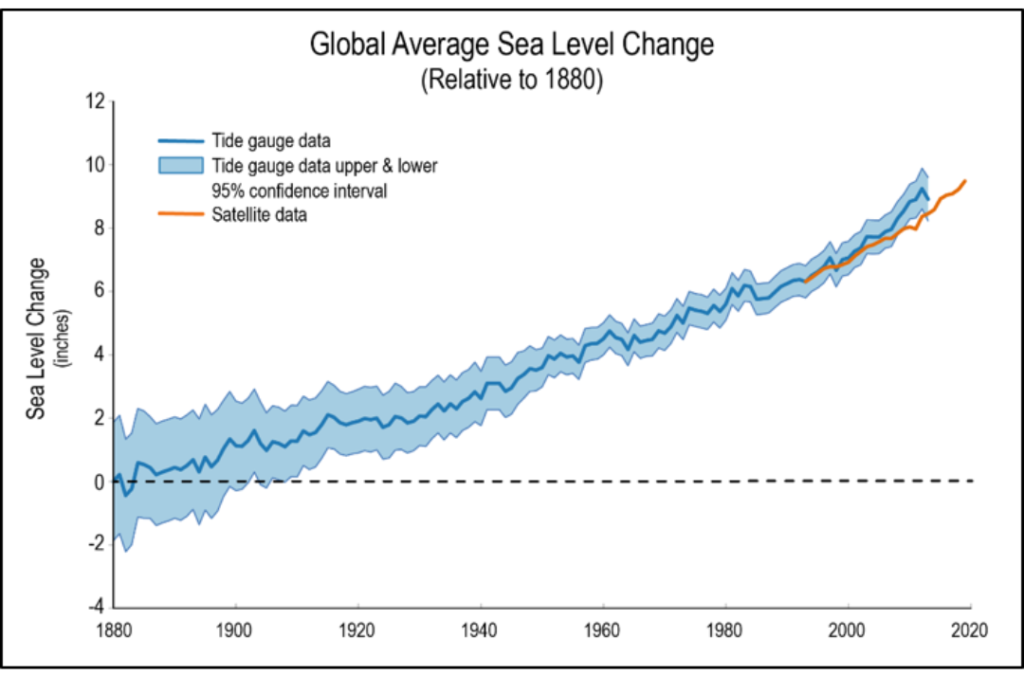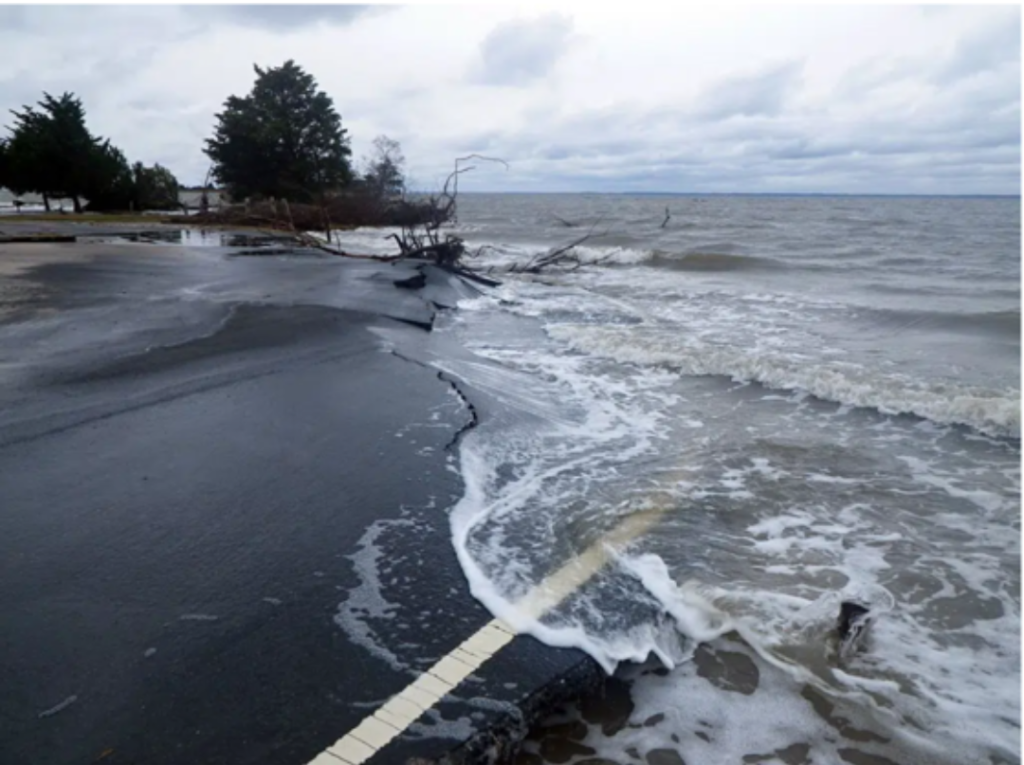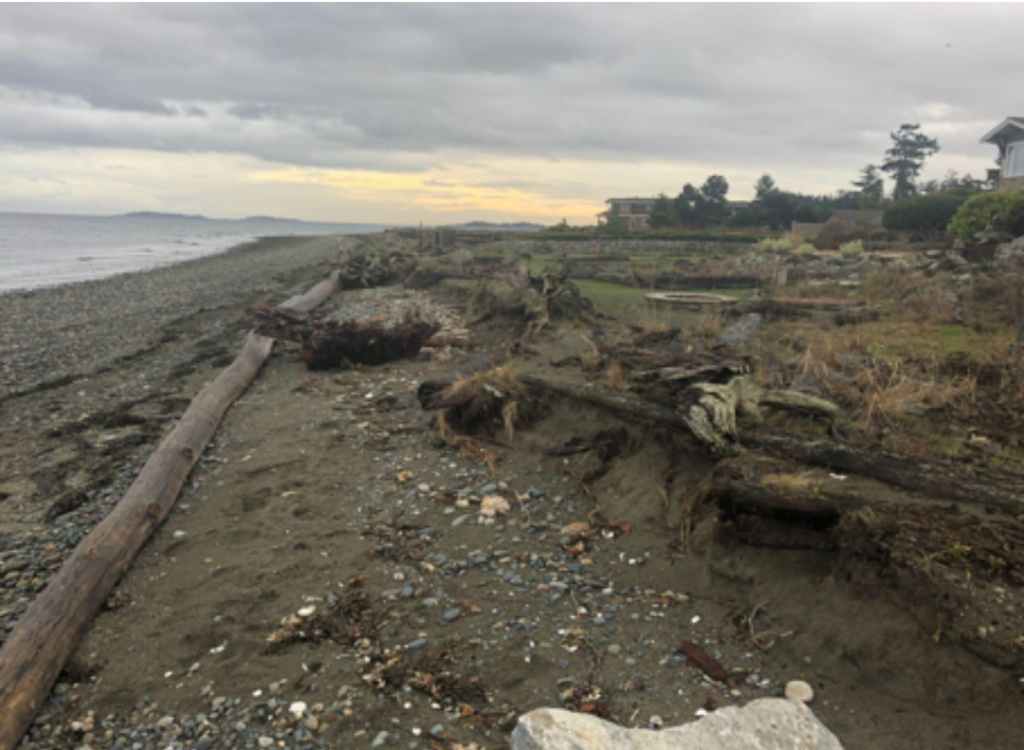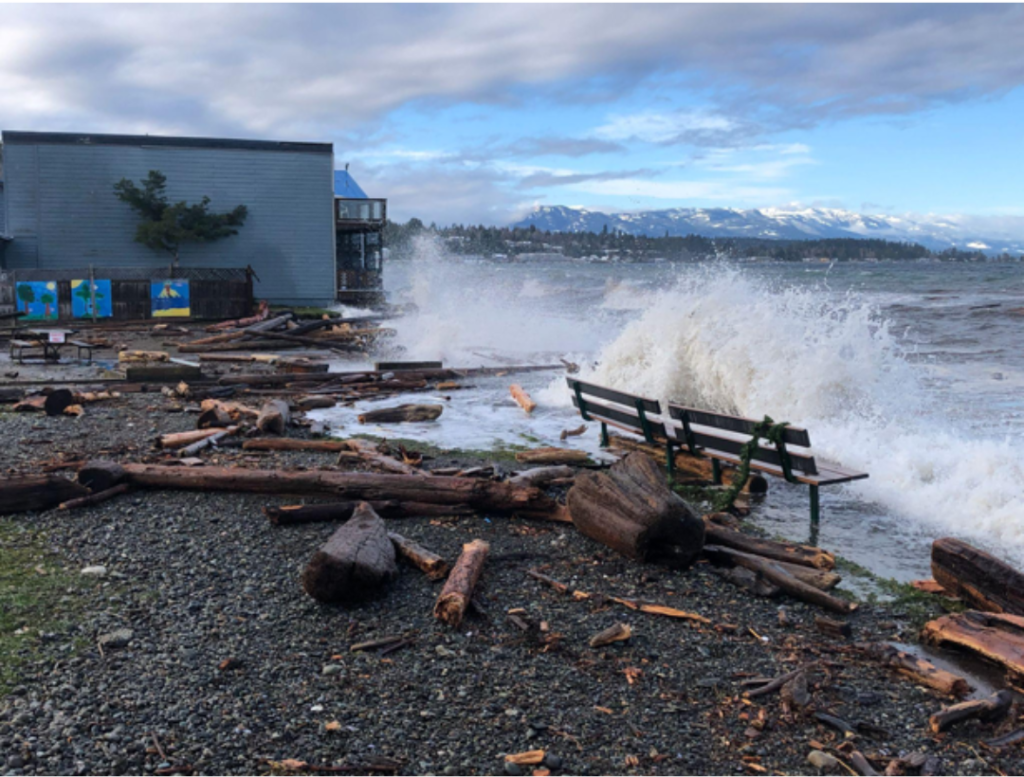Climate Change Impacts: Risks to the Shoreline
Changes in natural processes like sediment transport, erosion, and flooding can threaten shoreline properties. Climate change causes some of these changes, like sea-level rise. Sea-level rise occurs because global temperatures are increasing, causing ice masses on land to melt and contribute water volume to oceans, along with the increased thermal expansion (SNC- Lavalin 2014). As a result, sea-level rise influences shoreline erosion, causes loss of intertidal habitat, known as coastal squeeze, and worsens flooding and storm surge. Climate change also contributes to more frequent and intense storms that can cause damage to the shoreline (Bridges et al., 2021).
Today, with increased development and the application of traditional rigid infrastructure like hard armour (sea walls, rip rap, traditional dykes), coastal ecosystems are less adaptable, which leaves shoreline homeowners in danger of these shoreline risks. However, there are solutions. Implementing a Green Shores® nature-based approach will restore the shoreline to its natural state and will help increase its natural adaptive capacity and thus, can protect homeowners along the shoreline from these risks (Glick et al. 2020).

Click on the boxes below to learn about some of the shoreline risks and how homeowners can address them with nature-based approaches.
Sea-level rise occurs because global temperatures are increasing, causing ice masses on land to melt and contribute water volume to oceans, along with the increased thermal expansion (SNC- Lavalin 2014). As global temperatures increase with continued greenhouse gas emissions, further sea-level rise is inevitable due to the thermal expansion of oceans and increased melting of land-based ice (SNC-Lavalin 2014).
The figure shows an increase in the global average sea level since 1880. (Source: U.S. Global Change Research Program, 2022).
In British Columbia, over half of the province’s Regional Districts are bounded by tidal waters and exposed to the risk of sea-level rise (SNC-Lavalin 2014). Sea level rise has many cascading effects throughout coastal ecosystems and inland areas as well (SNC-Lavalin 2014). For example, climate change increases storm intensity which means increased winds and wave heights, leading to increased erosion. The combination of erosion and intense storms will leave upland areas, not typically impacted by floods, at risk of regular flooding and erosion (Eyquem 2021; PSF 2022).
Protecting vital coastal habitats, including wetlands and marshes, is a key nature-based approach to protecting coastal shoreline properties. In foreshore areas, healthy habitat with native vegetation helps to decrease wave energy from intense storms and mitigate erosion (Eyquem 2021). In upland areas, healthy riparian habitats will provide significant water storage to help mitigate flooding and provide filtration of upland run-off.
Coastal squeeze happens when a fixed structure defence prevents the natural inland migration of coastal habitats (Bridges et al. 2021). Due to the fixed structures, the coastal habitat is squeezed between the rising sea levels pushing it landward and the fixed structure holding it in place (Pontee 2013).
Coastal squeeze diagram: A) landward migration when no seawall is present, b) landward migration prevented by a seawall, c) landward migration prevented by a natural hill. (Source: Pontee 2013).
Coastal ecosystems adapt to rising sea levels by migrating landward to higher elevations (Eyquem 2021). The consequence of hard armouring is that the infrastructure is fixed in a certain spot, limiting the landward migration of coastal habitats (Eyquem 2021). The coastal habitats caught in this ‘coastal squeeze’ can become a serious risk to the shoreline. Without proper care and attention, coastal squeeze can cause a complete loss of the intertidal habitat (PSF 2022) and can leave shoreline properties completely exposed to coastal flooding and shoreline erosion (Eyquem 2021).
Shoreline migration is inevitable due to the dynamic nature of shoreline processes (PSF Primer 2022). Using nature-based approaches on the shoreline works with, not against, landward migration which sustains the intertidal habitat. It is vital that shoreline habitats are maintained as they serve significant roles for diffusing wave energy, storing flood water, and filtering contaminants from upland areas. Together these protect shoreline properties from flooding and erosion (Eyquem 2021).
Flooding in coastal areas can be associated with storm surges, and extreme high tides (King Tides) even in the absence of storms. Surface flooding can occur when rainfall exceeds the capacity of drainage systems, such as urban stormwater infrastructure (Glick et al. 2020) or when upland areas have large amounts of impervious surface.
Flooding along a shoreline caused by climate change-induced sea-level rise (Source: William A. Stiles Jr. 2018).
Floods are a natural shoreline process; however, the risk of damage from flooding is increased by hard shoreline infrastructure (Glick et al. 2020). Impervious surfaces such as paved roads and sea walls prevent the flow and infiltration of rainfall and contribute to significant runoff (Glick et al. 2020). Upland properties without permeable surfaces face increased runoff, limited filtration and higher contaminants due to increased surface runoff. In addition, coastal properties face flooding from higher water levels due to sea-level rise.
Nature-based approaches can effectively reduce the risk of flooding and provide additional benefits such as improved water quality and habitat for fish and other wildlife (Glick et al. 2020). For example, strategies for upland properties include rain gardens and permeable pavement to provide water storage and infiltration. In addition, the restoration and preservation of coastal habitats such as marshes, mangroves, and coral reefs in coastal properties can significantly reduce flooding by providing water storage and decreasing wave energy (Glick et al. 2020).
“Coastal erosion is a natural process by which sediment is removed from an area and transported along or away from the coast, usually by wind, waves and/or currents” (Eyquem 2021). Sediment deposition occurs when the sediment is transported to another location along the shoreline.
Image of shoreline erosion (Source: Kelly Loch).
Coastal erosion becomes a risk to shoreline homeowners when sediment transport gets interrupted or when intense waves from storms crash higher on the shoreline (Eyquem 2021, PSF 2022). Hard armour, like sea walls, can increase the risk of erosion on the shoreline because they limit the supply of sediment and contribute to undercutting from intense waves, eventually leading to sea wall collapse and failure (Eyquem 2021; PSF 2022). When erosion gets to this extent, shoreline properties are at risk of flooding and more significant damage (PSF 2022).
Nature-based approaches can mitigate the risk of erosion by providing a ‘soft shore’ and allowing the natural movement of sediment along the shoreline. It accommodates sediment transport and ensures that existing sediment supplies are maintained. With nature-based approaches, sediment can be transported naturally and safely, nourishing the beach to maintain its integrity.
“Storm surges are changes in the water levels occurring in response to the direct effects of wind and atmospheric pressure fluctuations during the passage of storms” (Eyquem 2021).
Waves from a storm crashing onto the shoreline (Source: Kelly Loch).
Climate change leads to increased storms and therefore storm surges. As a result, shoreline processes like sediment erosion and deposition can become more pronounced during extreme weather events (Eyquem 2021). For example, strong waves and currents can move large volumes of sediment and material during storm surges (Eyquem 2021). This can result in erosion of coastline properties or overtopping or flattening of natural coastal features that protect the shoreline, as large amounts of sediment are transported landward or into the ocean (Eyquem 2021). Storm surges become a severe risk to coastal properties with this cascading effect.
Nature-based approaches are vital in protecting shoreline properties against storm surge risks. They can facilitate the restoration of marshes and wetlands, which provide many services in shoreline protection. These coastal ecosystems can protect shoreline and inland properties by dissipating wave energy, reducing erosion, increasing stormwater infiltration, and can self-recover from damage from major storm surge events (Eyquem 2021).
Bridges, T. S., J. K. King, J. D. Simm, M. W. Beck, G. Collins, Q. Lodder, and R. K. Mohan, eds. (2021). International Guidelines on Natural and Nature‐Based Features for Flood Risk Management. Vicksburg, MS: U.S. Army Engineer Research and Development Center. Source link.
Eyquem, J. L. (2021). Rising Seas and Shifting Sands: Combining Natural and Grey Infrastructure to Protect Canada’s Coastal Communities. Intact Centre on Climate Adaptation, University of Waterloo. Source link.
Glick, P , Powell, E , Schlesinger, S , Ritter, J , Stein, B A , and Fuller, A. (2020). The Protective Value of Nature: A Review of the Effectiveness of Natural Infrastructure for Hazard Risk Reduction. Washington, DC: National Wildlife Federation. Source link.
Grant, S C H, MacDonald, B L , and Winston, M L. (2019) State of Canadian Pacific Salmon: Responses to Changing Climate and Habitats. Canadian Technical Report of Fisheries and Aquatic Sciences 3332. Source link.
Pontee. (2013). Defining coastal squeeze: A discussion. Ocean & Coastal Management, 84, 204–207. Source link.
SNC-Lavalin. (2014). Greening Shorelines to Enhance Resilience: An evaluation of approaches for adaptation to sea-level rise. Source link.
The Pacific Salmon Foundation (PSF). (2022). Impacts of Climate Change on Shorelines: Nature-Based Approaches for Ecosystem Health. Climate Change Primer. Source Link.
U.S. Global Change Research Program. (2022). Obtained June 14, 2022. Source link.
William A. Stiles Jr. (2018) Bulletin of the Atomic Scientists. Obtained June 14, 2022. Source link.
The shoreline has many natural processes. However, climate change negatively impacts these processes and shoreline property owners often face serious risks due to these changes. Conventional hard armouring is not as adaptable and can worsen shoreline risks. In order to protect shoreline properties, nature-based approaches should be considered as the first line of defence. Nature-based approaches can adapt and facilitate the natural processes of the shoreline to maintain a healthy ecosystem. They can dissipate wave energy, reduce erosion, increase stormwater infiltration, and self-recover from damage caused by storm surge events (Eyquem 2021).
Protect your shoreline with Green Shores® nature-based solutions
Stewardship Centre for BC’s Green Shores program utilizes nature-based solutions for shoreline management. This program aids homeowners in protecting their shoreline property from risks highlighted in this blog. In addition, our Green Shores program offers certification for home and development properties. Visit our Green Shores website or contact us at info@stewardshipcentrebc.ca to learn more!










